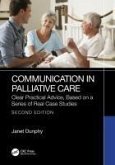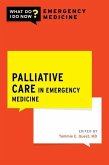Evidence-Based Practice of Palliative Medicine
Herausgeber: Goldstein, Nathan E; Morrison, R Sean; Woodrell, Christopher D
Evidence-Based Practice of Palliative Medicine
Herausgeber: Goldstein, Nathan E; Morrison, R Sean; Woodrell, Christopher D
- Broschiertes Buch
- Merkliste
- Auf die Merkliste
- Bewerten Bewerten
- Teilen
- Produkt teilen
- Produkterinnerung
- Produkterinnerung
Using a practical, question-and-answer approach, Evidence-Based Practice of Palliative Medicine, 2nd Edition, helps you provide optimal care for patients and families who are dealing with serious illness. This unique reference focuses on patient and family/caregiver-centered care, highlighting the benefits of palliative care and best practices for delivery. The highly practical, user-friendly format sets it apart from other texts in the field, with concise, readable chapters organized around clinical questions that you’re most likely to encounter in everyday care. * Uniquely organized using a…mehr
Andere Kunden interessierten sich auch für
![Psycho-Oncology in Palliative and End of Life Care Psycho-Oncology in Palliative and End of Life Care]() Psycho-Oncology in Palliative and End of Life Care79,99 €
Psycho-Oncology in Palliative and End of Life Care79,99 €![Communication in Palliative Care Communication in Palliative Care]() Janet DunphyCommunication in Palliative Care37,99 €
Janet DunphyCommunication in Palliative Care37,99 €![Palliative Care in Emergency Medicine Palliative Care in Emergency Medicine]() Palliative Care in Emergency Medicine51,99 €
Palliative Care in Emergency Medicine51,99 €![The Changing Face of Volunteering in Hospice and Palliative Care The Changing Face of Volunteering in Hospice and Palliative Care]() The Changing Face of Volunteering in Hospice and Palliative Care57,99 €
The Changing Face of Volunteering in Hospice and Palliative Care57,99 €![Oxford Textbook of Palliative Medicine Oxford Textbook of Palliative Medicine]() Oxford Textbook of Palliative Medicine157,99 €
Oxford Textbook of Palliative Medicine157,99 €![Managing Cancer and Living Meaningfully Managing Cancer and Living Meaningfully]() Gary Rodin (University of Toronto )Managing Cancer and Living Meaningfully77,99 €
Gary Rodin (University of Toronto )Managing Cancer and Living Meaningfully77,99 €![Advanced Practice Palliative Nursing 2nd Edition Advanced Practice Palliative Nursing 2nd Edition]() Constance Dahlin (Palliative Nurse P Palliative Nurse PractitionerAdvanced Practice Palliative Nursing 2nd Edition132,99 €
Constance Dahlin (Palliative Nurse P Palliative Nurse PractitionerAdvanced Practice Palliative Nursing 2nd Edition132,99 €-
-
-
Using a practical, question-and-answer approach, Evidence-Based Practice of Palliative Medicine, 2nd Edition, helps you provide optimal care for patients and families who are dealing with serious illness. This unique reference focuses on patient and family/caregiver-centered care, highlighting the benefits of palliative care and best practices for delivery. The highly practical, user-friendly format sets it apart from other texts in the field, with concise, readable chapters organized around clinical questions that you’re most likely to encounter in everyday care. * Uniquely organized using a question-and-answer approach, making it easy to find answers to common questions asked by practitioners and patients * Up-to-date, reader-friendly chapters explore interventions, assessment techniques, treatment modalities, recommendations and guidelines, communication techniques, and available resources for palliative care * Expanded discussions on hospice in every chapter, and a new emphasis on pediatrics, with increased material on pediatric malignancies, developmental delays, cystic fibrosis, and perinatal palliative care * New chapters on wellness of the palliative care practitioner, patients with opioid use disorders, telehealth in palliative care, health disparities, rural palliative care, caring for people with hematologic malignancies, integrative and alternative therapies, LGBTQ+ populations, mobile health technologies, and national palliative care implementation strategies * High-quality evidence gathered and reviewed by leading experts in palliative medicine, including clinicians, educators, and researchers across a broad range of disciplines * Numerous algorithms throughout help you make informed decisions, and "take-home" points in every chapter provide a quick summary of key content * Enhanced eBook version included with purchase. Your enhanced eBook allows you to access all of the text and figures from the book on a variety of devices
Produktdetails
- Produktdetails
- Verlag: Elsevier - Health Sciences Division
- 2 ed
- Seitenzahl: 736
- Erscheinungstermin: 25. Januar 2024
- Englisch
- Abmessung: 275mm x 214mm x 26mm
- Gewicht: 1578g
- ISBN-13: 9780323847025
- ISBN-10: 0323847021
- Artikelnr.: 64202005
- Herstellerkennzeichnung
- Libri GmbH
- Europaallee 1
- 36244 Bad Hersfeld
- gpsr@libri.de
- Verlag: Elsevier - Health Sciences Division
- 2 ed
- Seitenzahl: 736
- Erscheinungstermin: 25. Januar 2024
- Englisch
- Abmessung: 275mm x 214mm x 26mm
- Gewicht: 1578g
- ISBN-13: 9780323847025
- ISBN-10: 0323847021
- Artikelnr.: 64202005
- Herstellerkennzeichnung
- Libri GmbH
- Europaallee 1
- 36244 Bad Hersfeld
- gpsr@libri.de
Part I: Symptom Management
Section A PAIN
1. How Should Opioids Be Started and Titrated?
2. What Principles Should Guide Opioid Dose Conversions?
3. How Is Patient-Controlled Analgesia Best Used to Control Pain?
4. Which Opioids Are Safest and Most Effective in Patients With Renal or
Hepatic Failure?
5. How Should Methadone Be Started and Titrated in Opioid-Naïve and
Opioid-Exposed Patients?
6. What Is Neuropathic Pain and How Is It Best Managed?
7. How Are Adjuvant Medications Such as Corticosteroids and NSAIDs Used for
Pain Management?
8. What Are the Approaches to Pain in Skeletal Bone Disease?
9. When and How Should Radiotherapy Be Considered for Pain Management?
10. What Principles Should Guide the Prescribing of Opioids for Noncancer
Pain?
11. How Does the Opioid Epidemic Impact Palliative Medicine Practice?
12. How Does One Approach the Patient With an Opioid Use Disorder?
13. When Should Epidural or Intrathecal Medications and Pumps Be Considered
for Pain Management?
14. When Should Nerve Blocks Be Used for Pain Management?
Section B DYSPNEA
15. What Interventions Are Effective for Managing Dyspnea in People With
Cancer?
16. What Interventions Are Effective for Managing Dyspnea in COPD?
17. What Interventions Are Effective for Managing Dyspnea in Heart Failure?
Section C GASTROINTESTINAL
18. What Medications Are Effective in Preventing and Relieving Constipation
in the Setting of Opioid Use?
19. How Should Medications Be Initiated and Titrated to Reduce Acute and
Delayed Nausea and Vomiting in the Setting of Chemotherapy?
20. How Should Medications Be Initiated and Titrated to Prevent and Treat
Nausea and Vomiting in Clinical Situations Unrelated to Chemotherapy?
21. What Interventions Are Effective for Relieving Acute Bowel Obstruction
in Cancer and Other Conditions?
Section D ANOREXIA/CACHEXIA/FEEDING DIFFICULTIES
22. What Therapies Are Effective in Improving Anorexia and Weight Loss in
Cancer?
23. What Therapeutic Strategies Are Effective in Improving Anorexia and
Weight Loss in Nonmalignant Disease?
24. What Is the Role of Parenteral and Enteral Nutrition in Patients With
Cancer and With Noncancer Illness?
Section E PSYCHIATRIC SYMPTOMS
25. What Treatments Are Effective for Depression in Palliative Care
Settings?
26. How Are Anxiety and Fear Best Treated in Patients With Serious Illness
and in Those Facing the End of Life?
27. What Is the Approach to the Patient Seeking a Hastened Death?
Section F DELIRIUM
28. What Is Delirium and How Should It Be Managed?
29. What Are Effective Pharmacological and Nonpharmacological Treatments
for Delirium?
Section G SYMPTOMS AT THE END OF LIFE
30. How Do Symptoms Change for Patients in the Last Days/Hours of Life?
Part II: Communication
31. How is Prognosis Estimated and Communicated for People Facing Serious
Illness?
32. What Are the Key Elements to Having a Conversation About Communicating
Serious News and Setting Goals?
33. What Are the Elements of Advance Care Planning and What Is the Evidence
That Advance Care Planning Changes Patient Outcomes?
34. What Are the Special Communication Issues Involved in Caring for
Pediatric Patients?
Part III: Disease-Specific Topics
Section A CANCER
35. What Is the Role for Palliative Care in Patients With Advanced
Solid-Tumor Malignancies?
36. What Is the Clinical Course of Advanced Solid-Tumor Cancers?
37. What Is the Role for Palliative Care in Patients With Advanced
Hematologic Malignancies?
38. What Is the Clinical Course of Hematologic Malignancies?
39. What Is the Role for Palliative Care in Children With Cancer?
40. What Is the Clinical Course of Pediatric Cancers?
Section B DEMENTIA
41. What Is the Clinical Course of Advanced Dementia?
42. What Are Appropriate Palliative Interventions for Patients With
Advanced Dementia?
Section C ADVANCED LIVER DISEASE
43. What Are the Causes and Complications of Chronic Liver Disease and What
Is the Evidence for Palliative Care Delivery to Those Affected by It?
44. What Do We Know About the Symptoms and Palliative Care Needs of People
Affected by Liver Disease?
Section D BRAIN FUNCTION
45. What Is the Role of Palliative Care in Stroke?
46. What Special Considerations Are Needed for Individuals With Amyotrophic
Lateral Sclerosis, Parkinson’s Disease, and Multiple Sclerosis?
Section E HEART FAILURE
47. What Is the Clinical Course of Advanced Heart Failure and How Do
Implanted Cardiac Devices Alter This Course?
Section F CHRONIC CRITICAL ILLNESS
48. What Is Chronic Critical Illness and What Outcomes Can Be Expected
Section G HEAD AND NECK CANCER
49. What Special Considerations Are Needed in Patients With Head and Neck
Cancer?
Section H END-STAGE RENAL DISEASE
50. What Special Considerations Are Needed in Treating Symptoms in Patients
With End-Stage Renal Disease, and How Should Patients Who Stop Dialysis Be
Managed?
51. What Are Palliative Alternatives to Renal Replacement Therapy for
People With Advanced Kidney Failure?
Section I PULMONARY
52. What Special Considerations Are Needed for Patients With Advanced Lung
Disease?
Section J GERIATRICS
53. What Are the Special Needs of Older Adults With Serious Illness?
54. What Are Multimorbidity and Frailty and How Do They Affect the Care of
Older Adults?
Section K PEDIATRICS
55. What Are Special Considerations for Pediatric Palliative Care?
56. What Are Special Considerations for Dosing Medications in Pediatric
Populations?
57. How Are Children With Developmental Diseases and Delays Best Managed in
Palliative Care?
58. What Are Special Considerations for Perinatal Palliative Care?
59. What Are Special Considerations for Patients With Cystic Fibrosis?
PART IV: Special Topics
Section A PALLIATIVE CARE EMERGENCIES
60. What Are the Signs, Symptoms, and Treatments of Spinal Cord
Compression?
61. What Framework Can Be Used to Address Uncontrolled Symptoms at the End
of Life?
Section B FINANCIAL ASPECTS OF PALLIATIVE CARE
62. What Are the Arguments That Show That Palliative Care Is Beneficial to
Hospitals?
63. What Are the Arguments That Show That Outpatient Palliative Care Is
Beneficial to Medical Systems?
Section C CAREGIVERS
64. How Does Serious Illness Impact Family Caregivers?
65. What Can Be Done to Improve Outcomes for Caregivers of People With
Serious Illness?
66. What Is Prolonged Grief Disorder and How Can Its Likelihood Be Reduced?
Section D SETTINGS FOR PALLIATIVE CARE DELIVERY
67. What Are Models for Delivering Palliative Care in Hospitals?
68. What Models Exist for Delivering Palliative Care and Hospice in Nursing
Homes?
69. What Are the Models for Delivering Palliative Care in the Ambulatory
Practice Setting?
70. What Are the Models for Delivering Palliative Care in the Home?
71. What Are the Models for Delivering Palliative Care in Rural Areas?
72. How Is Palliative Care Best Integrated Into Surgical Services?
73. What Models Exist to Deliver Palliative Care via Telemedicine?
74. What are National Strategies and Frameworks for Palliative Care?
75. What Are Sources of Spiritual and Existential Suffering for Patients
With Advanced Illness?
76. What Are the Racial and Ethnic Health Disparities That Exist in
Palliative Care?
77. What Are the Palliative Care Needs of LGBTQ+ People?
78. What Is the Evidence for Integrative and Alternative Therapies in
Palliative Care?
79. What Is the Evidence Supporting the Use of Mobile Health Technologies
in Palliative Care?
80. How Can Clinician Well-Being Be Improved and Sustained in Palliative
Care?
Section A PAIN
1. How Should Opioids Be Started and Titrated?
2. What Principles Should Guide Opioid Dose Conversions?
3. How Is Patient-Controlled Analgesia Best Used to Control Pain?
4. Which Opioids Are Safest and Most Effective in Patients With Renal or
Hepatic Failure?
5. How Should Methadone Be Started and Titrated in Opioid-Naïve and
Opioid-Exposed Patients?
6. What Is Neuropathic Pain and How Is It Best Managed?
7. How Are Adjuvant Medications Such as Corticosteroids and NSAIDs Used for
Pain Management?
8. What Are the Approaches to Pain in Skeletal Bone Disease?
9. When and How Should Radiotherapy Be Considered for Pain Management?
10. What Principles Should Guide the Prescribing of Opioids for Noncancer
Pain?
11. How Does the Opioid Epidemic Impact Palliative Medicine Practice?
12. How Does One Approach the Patient With an Opioid Use Disorder?
13. When Should Epidural or Intrathecal Medications and Pumps Be Considered
for Pain Management?
14. When Should Nerve Blocks Be Used for Pain Management?
Section B DYSPNEA
15. What Interventions Are Effective for Managing Dyspnea in People With
Cancer?
16. What Interventions Are Effective for Managing Dyspnea in COPD?
17. What Interventions Are Effective for Managing Dyspnea in Heart Failure?
Section C GASTROINTESTINAL
18. What Medications Are Effective in Preventing and Relieving Constipation
in the Setting of Opioid Use?
19. How Should Medications Be Initiated and Titrated to Reduce Acute and
Delayed Nausea and Vomiting in the Setting of Chemotherapy?
20. How Should Medications Be Initiated and Titrated to Prevent and Treat
Nausea and Vomiting in Clinical Situations Unrelated to Chemotherapy?
21. What Interventions Are Effective for Relieving Acute Bowel Obstruction
in Cancer and Other Conditions?
Section D ANOREXIA/CACHEXIA/FEEDING DIFFICULTIES
22. What Therapies Are Effective in Improving Anorexia and Weight Loss in
Cancer?
23. What Therapeutic Strategies Are Effective in Improving Anorexia and
Weight Loss in Nonmalignant Disease?
24. What Is the Role of Parenteral and Enteral Nutrition in Patients With
Cancer and With Noncancer Illness?
Section E PSYCHIATRIC SYMPTOMS
25. What Treatments Are Effective for Depression in Palliative Care
Settings?
26. How Are Anxiety and Fear Best Treated in Patients With Serious Illness
and in Those Facing the End of Life?
27. What Is the Approach to the Patient Seeking a Hastened Death?
Section F DELIRIUM
28. What Is Delirium and How Should It Be Managed?
29. What Are Effective Pharmacological and Nonpharmacological Treatments
for Delirium?
Section G SYMPTOMS AT THE END OF LIFE
30. How Do Symptoms Change for Patients in the Last Days/Hours of Life?
Part II: Communication
31. How is Prognosis Estimated and Communicated for People Facing Serious
Illness?
32. What Are the Key Elements to Having a Conversation About Communicating
Serious News and Setting Goals?
33. What Are the Elements of Advance Care Planning and What Is the Evidence
That Advance Care Planning Changes Patient Outcomes?
34. What Are the Special Communication Issues Involved in Caring for
Pediatric Patients?
Part III: Disease-Specific Topics
Section A CANCER
35. What Is the Role for Palliative Care in Patients With Advanced
Solid-Tumor Malignancies?
36. What Is the Clinical Course of Advanced Solid-Tumor Cancers?
37. What Is the Role for Palliative Care in Patients With Advanced
Hematologic Malignancies?
38. What Is the Clinical Course of Hematologic Malignancies?
39. What Is the Role for Palliative Care in Children With Cancer?
40. What Is the Clinical Course of Pediatric Cancers?
Section B DEMENTIA
41. What Is the Clinical Course of Advanced Dementia?
42. What Are Appropriate Palliative Interventions for Patients With
Advanced Dementia?
Section C ADVANCED LIVER DISEASE
43. What Are the Causes and Complications of Chronic Liver Disease and What
Is the Evidence for Palliative Care Delivery to Those Affected by It?
44. What Do We Know About the Symptoms and Palliative Care Needs of People
Affected by Liver Disease?
Section D BRAIN FUNCTION
45. What Is the Role of Palliative Care in Stroke?
46. What Special Considerations Are Needed for Individuals With Amyotrophic
Lateral Sclerosis, Parkinson’s Disease, and Multiple Sclerosis?
Section E HEART FAILURE
47. What Is the Clinical Course of Advanced Heart Failure and How Do
Implanted Cardiac Devices Alter This Course?
Section F CHRONIC CRITICAL ILLNESS
48. What Is Chronic Critical Illness and What Outcomes Can Be Expected
Section G HEAD AND NECK CANCER
49. What Special Considerations Are Needed in Patients With Head and Neck
Cancer?
Section H END-STAGE RENAL DISEASE
50. What Special Considerations Are Needed in Treating Symptoms in Patients
With End-Stage Renal Disease, and How Should Patients Who Stop Dialysis Be
Managed?
51. What Are Palliative Alternatives to Renal Replacement Therapy for
People With Advanced Kidney Failure?
Section I PULMONARY
52. What Special Considerations Are Needed for Patients With Advanced Lung
Disease?
Section J GERIATRICS
53. What Are the Special Needs of Older Adults With Serious Illness?
54. What Are Multimorbidity and Frailty and How Do They Affect the Care of
Older Adults?
Section K PEDIATRICS
55. What Are Special Considerations for Pediatric Palliative Care?
56. What Are Special Considerations for Dosing Medications in Pediatric
Populations?
57. How Are Children With Developmental Diseases and Delays Best Managed in
Palliative Care?
58. What Are Special Considerations for Perinatal Palliative Care?
59. What Are Special Considerations for Patients With Cystic Fibrosis?
PART IV: Special Topics
Section A PALLIATIVE CARE EMERGENCIES
60. What Are the Signs, Symptoms, and Treatments of Spinal Cord
Compression?
61. What Framework Can Be Used to Address Uncontrolled Symptoms at the End
of Life?
Section B FINANCIAL ASPECTS OF PALLIATIVE CARE
62. What Are the Arguments That Show That Palliative Care Is Beneficial to
Hospitals?
63. What Are the Arguments That Show That Outpatient Palliative Care Is
Beneficial to Medical Systems?
Section C CAREGIVERS
64. How Does Serious Illness Impact Family Caregivers?
65. What Can Be Done to Improve Outcomes for Caregivers of People With
Serious Illness?
66. What Is Prolonged Grief Disorder and How Can Its Likelihood Be Reduced?
Section D SETTINGS FOR PALLIATIVE CARE DELIVERY
67. What Are Models for Delivering Palliative Care in Hospitals?
68. What Models Exist for Delivering Palliative Care and Hospice in Nursing
Homes?
69. What Are the Models for Delivering Palliative Care in the Ambulatory
Practice Setting?
70. What Are the Models for Delivering Palliative Care in the Home?
71. What Are the Models for Delivering Palliative Care in Rural Areas?
72. How Is Palliative Care Best Integrated Into Surgical Services?
73. What Models Exist to Deliver Palliative Care via Telemedicine?
74. What are National Strategies and Frameworks for Palliative Care?
75. What Are Sources of Spiritual and Existential Suffering for Patients
With Advanced Illness?
76. What Are the Racial and Ethnic Health Disparities That Exist in
Palliative Care?
77. What Are the Palliative Care Needs of LGBTQ+ People?
78. What Is the Evidence for Integrative and Alternative Therapies in
Palliative Care?
79. What Is the Evidence Supporting the Use of Mobile Health Technologies
in Palliative Care?
80. How Can Clinician Well-Being Be Improved and Sustained in Palliative
Care?
Part I: Symptom Management
Section A PAIN
1. How Should Opioids Be Started and Titrated?
2. What Principles Should Guide Opioid Dose Conversions?
3. How Is Patient-Controlled Analgesia Best Used to Control Pain?
4. Which Opioids Are Safest and Most Effective in Patients With Renal or
Hepatic Failure?
5. How Should Methadone Be Started and Titrated in Opioid-Naïve and
Opioid-Exposed Patients?
6. What Is Neuropathic Pain and How Is It Best Managed?
7. How Are Adjuvant Medications Such as Corticosteroids and NSAIDs Used for
Pain Management?
8. What Are the Approaches to Pain in Skeletal Bone Disease?
9. When and How Should Radiotherapy Be Considered for Pain Management?
10. What Principles Should Guide the Prescribing of Opioids for Noncancer
Pain?
11. How Does the Opioid Epidemic Impact Palliative Medicine Practice?
12. How Does One Approach the Patient With an Opioid Use Disorder?
13. When Should Epidural or Intrathecal Medications and Pumps Be Considered
for Pain Management?
14. When Should Nerve Blocks Be Used for Pain Management?
Section B DYSPNEA
15. What Interventions Are Effective for Managing Dyspnea in People With
Cancer?
16. What Interventions Are Effective for Managing Dyspnea in COPD?
17. What Interventions Are Effective for Managing Dyspnea in Heart Failure?
Section C GASTROINTESTINAL
18. What Medications Are Effective in Preventing and Relieving Constipation
in the Setting of Opioid Use?
19. How Should Medications Be Initiated and Titrated to Reduce Acute and
Delayed Nausea and Vomiting in the Setting of Chemotherapy?
20. How Should Medications Be Initiated and Titrated to Prevent and Treat
Nausea and Vomiting in Clinical Situations Unrelated to Chemotherapy?
21. What Interventions Are Effective for Relieving Acute Bowel Obstruction
in Cancer and Other Conditions?
Section D ANOREXIA/CACHEXIA/FEEDING DIFFICULTIES
22. What Therapies Are Effective in Improving Anorexia and Weight Loss in
Cancer?
23. What Therapeutic Strategies Are Effective in Improving Anorexia and
Weight Loss in Nonmalignant Disease?
24. What Is the Role of Parenteral and Enteral Nutrition in Patients With
Cancer and With Noncancer Illness?
Section E PSYCHIATRIC SYMPTOMS
25. What Treatments Are Effective for Depression in Palliative Care
Settings?
26. How Are Anxiety and Fear Best Treated in Patients With Serious Illness
and in Those Facing the End of Life?
27. What Is the Approach to the Patient Seeking a Hastened Death?
Section F DELIRIUM
28. What Is Delirium and How Should It Be Managed?
29. What Are Effective Pharmacological and Nonpharmacological Treatments
for Delirium?
Section G SYMPTOMS AT THE END OF LIFE
30. How Do Symptoms Change for Patients in the Last Days/Hours of Life?
Part II: Communication
31. How is Prognosis Estimated and Communicated for People Facing Serious
Illness?
32. What Are the Key Elements to Having a Conversation About Communicating
Serious News and Setting Goals?
33. What Are the Elements of Advance Care Planning and What Is the Evidence
That Advance Care Planning Changes Patient Outcomes?
34. What Are the Special Communication Issues Involved in Caring for
Pediatric Patients?
Part III: Disease-Specific Topics
Section A CANCER
35. What Is the Role for Palliative Care in Patients With Advanced
Solid-Tumor Malignancies?
36. What Is the Clinical Course of Advanced Solid-Tumor Cancers?
37. What Is the Role for Palliative Care in Patients With Advanced
Hematologic Malignancies?
38. What Is the Clinical Course of Hematologic Malignancies?
39. What Is the Role for Palliative Care in Children With Cancer?
40. What Is the Clinical Course of Pediatric Cancers?
Section B DEMENTIA
41. What Is the Clinical Course of Advanced Dementia?
42. What Are Appropriate Palliative Interventions for Patients With
Advanced Dementia?
Section C ADVANCED LIVER DISEASE
43. What Are the Causes and Complications of Chronic Liver Disease and What
Is the Evidence for Palliative Care Delivery to Those Affected by It?
44. What Do We Know About the Symptoms and Palliative Care Needs of People
Affected by Liver Disease?
Section D BRAIN FUNCTION
45. What Is the Role of Palliative Care in Stroke?
46. What Special Considerations Are Needed for Individuals With Amyotrophic
Lateral Sclerosis, Parkinson’s Disease, and Multiple Sclerosis?
Section E HEART FAILURE
47. What Is the Clinical Course of Advanced Heart Failure and How Do
Implanted Cardiac Devices Alter This Course?
Section F CHRONIC CRITICAL ILLNESS
48. What Is Chronic Critical Illness and What Outcomes Can Be Expected
Section G HEAD AND NECK CANCER
49. What Special Considerations Are Needed in Patients With Head and Neck
Cancer?
Section H END-STAGE RENAL DISEASE
50. What Special Considerations Are Needed in Treating Symptoms in Patients
With End-Stage Renal Disease, and How Should Patients Who Stop Dialysis Be
Managed?
51. What Are Palliative Alternatives to Renal Replacement Therapy for
People With Advanced Kidney Failure?
Section I PULMONARY
52. What Special Considerations Are Needed for Patients With Advanced Lung
Disease?
Section J GERIATRICS
53. What Are the Special Needs of Older Adults With Serious Illness?
54. What Are Multimorbidity and Frailty and How Do They Affect the Care of
Older Adults?
Section K PEDIATRICS
55. What Are Special Considerations for Pediatric Palliative Care?
56. What Are Special Considerations for Dosing Medications in Pediatric
Populations?
57. How Are Children With Developmental Diseases and Delays Best Managed in
Palliative Care?
58. What Are Special Considerations for Perinatal Palliative Care?
59. What Are Special Considerations for Patients With Cystic Fibrosis?
PART IV: Special Topics
Section A PALLIATIVE CARE EMERGENCIES
60. What Are the Signs, Symptoms, and Treatments of Spinal Cord
Compression?
61. What Framework Can Be Used to Address Uncontrolled Symptoms at the End
of Life?
Section B FINANCIAL ASPECTS OF PALLIATIVE CARE
62. What Are the Arguments That Show That Palliative Care Is Beneficial to
Hospitals?
63. What Are the Arguments That Show That Outpatient Palliative Care Is
Beneficial to Medical Systems?
Section C CAREGIVERS
64. How Does Serious Illness Impact Family Caregivers?
65. What Can Be Done to Improve Outcomes for Caregivers of People With
Serious Illness?
66. What Is Prolonged Grief Disorder and How Can Its Likelihood Be Reduced?
Section D SETTINGS FOR PALLIATIVE CARE DELIVERY
67. What Are Models for Delivering Palliative Care in Hospitals?
68. What Models Exist for Delivering Palliative Care and Hospice in Nursing
Homes?
69. What Are the Models for Delivering Palliative Care in the Ambulatory
Practice Setting?
70. What Are the Models for Delivering Palliative Care in the Home?
71. What Are the Models for Delivering Palliative Care in Rural Areas?
72. How Is Palliative Care Best Integrated Into Surgical Services?
73. What Models Exist to Deliver Palliative Care via Telemedicine?
74. What are National Strategies and Frameworks for Palliative Care?
75. What Are Sources of Spiritual and Existential Suffering for Patients
With Advanced Illness?
76. What Are the Racial and Ethnic Health Disparities That Exist in
Palliative Care?
77. What Are the Palliative Care Needs of LGBTQ+ People?
78. What Is the Evidence for Integrative and Alternative Therapies in
Palliative Care?
79. What Is the Evidence Supporting the Use of Mobile Health Technologies
in Palliative Care?
80. How Can Clinician Well-Being Be Improved and Sustained in Palliative
Care?
Section A PAIN
1. How Should Opioids Be Started and Titrated?
2. What Principles Should Guide Opioid Dose Conversions?
3. How Is Patient-Controlled Analgesia Best Used to Control Pain?
4. Which Opioids Are Safest and Most Effective in Patients With Renal or
Hepatic Failure?
5. How Should Methadone Be Started and Titrated in Opioid-Naïve and
Opioid-Exposed Patients?
6. What Is Neuropathic Pain and How Is It Best Managed?
7. How Are Adjuvant Medications Such as Corticosteroids and NSAIDs Used for
Pain Management?
8. What Are the Approaches to Pain in Skeletal Bone Disease?
9. When and How Should Radiotherapy Be Considered for Pain Management?
10. What Principles Should Guide the Prescribing of Opioids for Noncancer
Pain?
11. How Does the Opioid Epidemic Impact Palliative Medicine Practice?
12. How Does One Approach the Patient With an Opioid Use Disorder?
13. When Should Epidural or Intrathecal Medications and Pumps Be Considered
for Pain Management?
14. When Should Nerve Blocks Be Used for Pain Management?
Section B DYSPNEA
15. What Interventions Are Effective for Managing Dyspnea in People With
Cancer?
16. What Interventions Are Effective for Managing Dyspnea in COPD?
17. What Interventions Are Effective for Managing Dyspnea in Heart Failure?
Section C GASTROINTESTINAL
18. What Medications Are Effective in Preventing and Relieving Constipation
in the Setting of Opioid Use?
19. How Should Medications Be Initiated and Titrated to Reduce Acute and
Delayed Nausea and Vomiting in the Setting of Chemotherapy?
20. How Should Medications Be Initiated and Titrated to Prevent and Treat
Nausea and Vomiting in Clinical Situations Unrelated to Chemotherapy?
21. What Interventions Are Effective for Relieving Acute Bowel Obstruction
in Cancer and Other Conditions?
Section D ANOREXIA/CACHEXIA/FEEDING DIFFICULTIES
22. What Therapies Are Effective in Improving Anorexia and Weight Loss in
Cancer?
23. What Therapeutic Strategies Are Effective in Improving Anorexia and
Weight Loss in Nonmalignant Disease?
24. What Is the Role of Parenteral and Enteral Nutrition in Patients With
Cancer and With Noncancer Illness?
Section E PSYCHIATRIC SYMPTOMS
25. What Treatments Are Effective for Depression in Palliative Care
Settings?
26. How Are Anxiety and Fear Best Treated in Patients With Serious Illness
and in Those Facing the End of Life?
27. What Is the Approach to the Patient Seeking a Hastened Death?
Section F DELIRIUM
28. What Is Delirium and How Should It Be Managed?
29. What Are Effective Pharmacological and Nonpharmacological Treatments
for Delirium?
Section G SYMPTOMS AT THE END OF LIFE
30. How Do Symptoms Change for Patients in the Last Days/Hours of Life?
Part II: Communication
31. How is Prognosis Estimated and Communicated for People Facing Serious
Illness?
32. What Are the Key Elements to Having a Conversation About Communicating
Serious News and Setting Goals?
33. What Are the Elements of Advance Care Planning and What Is the Evidence
That Advance Care Planning Changes Patient Outcomes?
34. What Are the Special Communication Issues Involved in Caring for
Pediatric Patients?
Part III: Disease-Specific Topics
Section A CANCER
35. What Is the Role for Palliative Care in Patients With Advanced
Solid-Tumor Malignancies?
36. What Is the Clinical Course of Advanced Solid-Tumor Cancers?
37. What Is the Role for Palliative Care in Patients With Advanced
Hematologic Malignancies?
38. What Is the Clinical Course of Hematologic Malignancies?
39. What Is the Role for Palliative Care in Children With Cancer?
40. What Is the Clinical Course of Pediatric Cancers?
Section B DEMENTIA
41. What Is the Clinical Course of Advanced Dementia?
42. What Are Appropriate Palliative Interventions for Patients With
Advanced Dementia?
Section C ADVANCED LIVER DISEASE
43. What Are the Causes and Complications of Chronic Liver Disease and What
Is the Evidence for Palliative Care Delivery to Those Affected by It?
44. What Do We Know About the Symptoms and Palliative Care Needs of People
Affected by Liver Disease?
Section D BRAIN FUNCTION
45. What Is the Role of Palliative Care in Stroke?
46. What Special Considerations Are Needed for Individuals With Amyotrophic
Lateral Sclerosis, Parkinson’s Disease, and Multiple Sclerosis?
Section E HEART FAILURE
47. What Is the Clinical Course of Advanced Heart Failure and How Do
Implanted Cardiac Devices Alter This Course?
Section F CHRONIC CRITICAL ILLNESS
48. What Is Chronic Critical Illness and What Outcomes Can Be Expected
Section G HEAD AND NECK CANCER
49. What Special Considerations Are Needed in Patients With Head and Neck
Cancer?
Section H END-STAGE RENAL DISEASE
50. What Special Considerations Are Needed in Treating Symptoms in Patients
With End-Stage Renal Disease, and How Should Patients Who Stop Dialysis Be
Managed?
51. What Are Palliative Alternatives to Renal Replacement Therapy for
People With Advanced Kidney Failure?
Section I PULMONARY
52. What Special Considerations Are Needed for Patients With Advanced Lung
Disease?
Section J GERIATRICS
53. What Are the Special Needs of Older Adults With Serious Illness?
54. What Are Multimorbidity and Frailty and How Do They Affect the Care of
Older Adults?
Section K PEDIATRICS
55. What Are Special Considerations for Pediatric Palliative Care?
56. What Are Special Considerations for Dosing Medications in Pediatric
Populations?
57. How Are Children With Developmental Diseases and Delays Best Managed in
Palliative Care?
58. What Are Special Considerations for Perinatal Palliative Care?
59. What Are Special Considerations for Patients With Cystic Fibrosis?
PART IV: Special Topics
Section A PALLIATIVE CARE EMERGENCIES
60. What Are the Signs, Symptoms, and Treatments of Spinal Cord
Compression?
61. What Framework Can Be Used to Address Uncontrolled Symptoms at the End
of Life?
Section B FINANCIAL ASPECTS OF PALLIATIVE CARE
62. What Are the Arguments That Show That Palliative Care Is Beneficial to
Hospitals?
63. What Are the Arguments That Show That Outpatient Palliative Care Is
Beneficial to Medical Systems?
Section C CAREGIVERS
64. How Does Serious Illness Impact Family Caregivers?
65. What Can Be Done to Improve Outcomes for Caregivers of People With
Serious Illness?
66. What Is Prolonged Grief Disorder and How Can Its Likelihood Be Reduced?
Section D SETTINGS FOR PALLIATIVE CARE DELIVERY
67. What Are Models for Delivering Palliative Care in Hospitals?
68. What Models Exist for Delivering Palliative Care and Hospice in Nursing
Homes?
69. What Are the Models for Delivering Palliative Care in the Ambulatory
Practice Setting?
70. What Are the Models for Delivering Palliative Care in the Home?
71. What Are the Models for Delivering Palliative Care in Rural Areas?
72. How Is Palliative Care Best Integrated Into Surgical Services?
73. What Models Exist to Deliver Palliative Care via Telemedicine?
74. What are National Strategies and Frameworks for Palliative Care?
75. What Are Sources of Spiritual and Existential Suffering for Patients
With Advanced Illness?
76. What Are the Racial and Ethnic Health Disparities That Exist in
Palliative Care?
77. What Are the Palliative Care Needs of LGBTQ+ People?
78. What Is the Evidence for Integrative and Alternative Therapies in
Palliative Care?
79. What Is the Evidence Supporting the Use of Mobile Health Technologies
in Palliative Care?
80. How Can Clinician Well-Being Be Improved and Sustained in Palliative
Care?








